Mythbusting: 3 Persistent Patek Philippe And Rolex Myths Debunked
The rise of the internet, and the consequent evolution of the watch-watching community, from its early days on forums and chat rooms into fully-fledged horology-related blogging and online retail empires, all fueled by social network apps like Instagram and Facebook, has inevitably amplified the phenomenon whereby certain objects come to exert an extraordinary hold over the collective imagination. This leads to certain watch brands becoming prized for their value as short-, medium-, or long-term investments rather than timekeeping devices. You could go so far as to regard them as a currency in their own right.
Against this feverish backdrop, rumors and legends abound. For there is no better way to boost the sale price of a vintage watch than to have it associated with a particular person or historical event. Case in point: the “Paul Newman Rolex Daytona,” which is not the same thing as the late Paul Newman’s Rolex Daytona(s), but the link is established in collectors’ minds and prices soar accordingly.
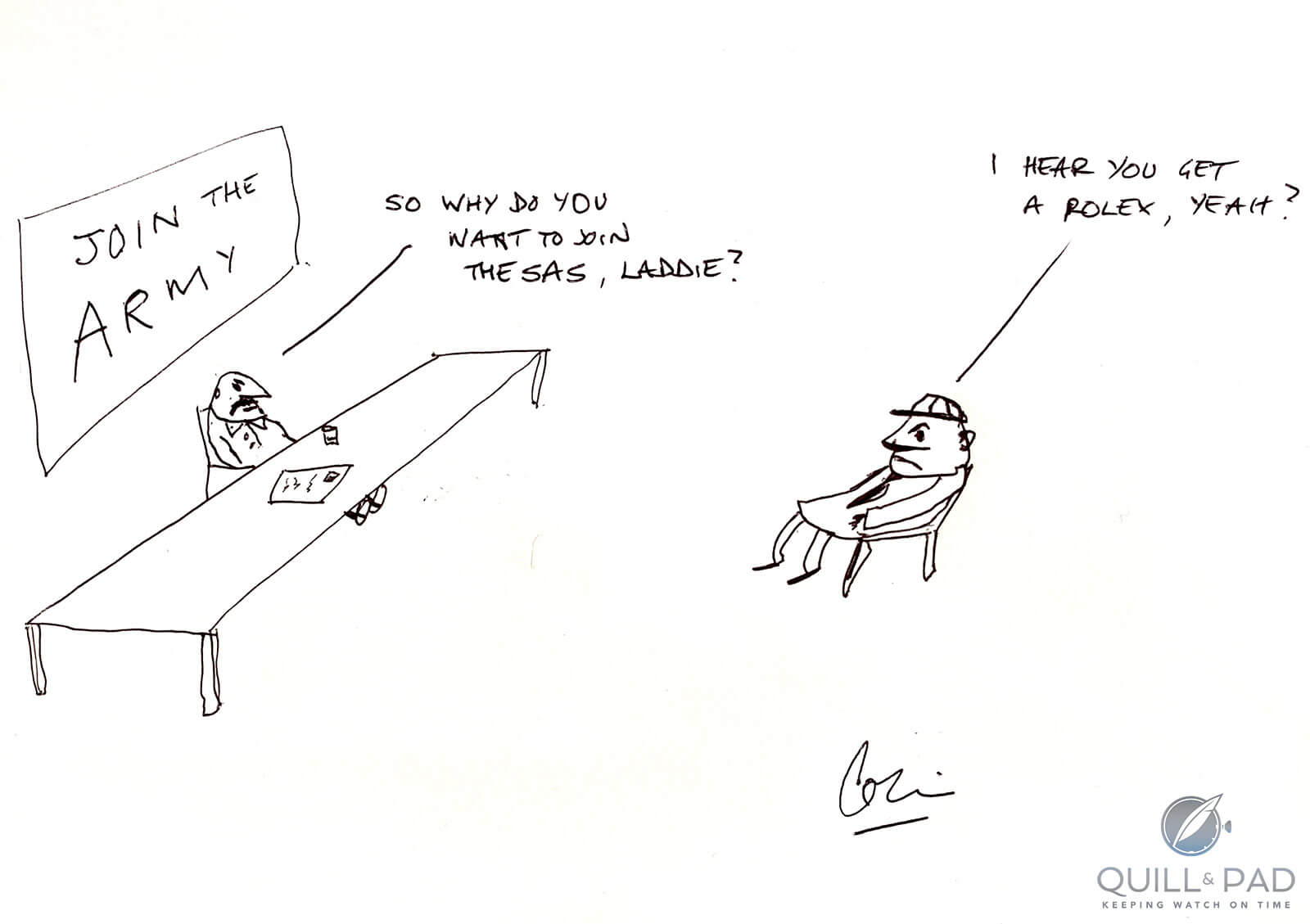
Myth Busting (sketch by Colin Alexander Smith)
Here are three watch myths circulating widely and freely online and in print, and in some cases these urban legends are brazenly perpetuated by persons and platforms who should know better.
Myth 1: Nicolas Sarkozy took off his Patek Philippe to shake hands with his supporters
Nicolas Sarkozy, president of France between 2007 and 2015, drew considerable flak from a broad section of French society for his undisguised taste for the good things in life (not to mention well-heeled personae), in particular after his post-election celebratory dinner at Fouquet’s in Paris in May 2007.
As anyone who follows both French politics and fine watchmaking may be aware, the nec plus ultra comment about Rolex watches was made by journalist Jacques Séguéla on a live chat show: responding to accusations that Sarkozy’s choice of wrist wear proved that he was the “bling-bling” president, Séguéla was simply pointing out that in the real world it’s quite normal for the president of a country to wear a Rolex.
“Why would you criticize a president for wearing a Rolex?” Séguéla postulated. “After all, everyone has a Rolex – if you don’t have a Rolex by the time you’re 50, you’re a failure.”
This statement, which was a perfectly banal and light-hearted observation, ricocheted round the media as evidence of how France’s media personalities, and by implication the president he was defending, are out of touch with “ordinary” French people, for whom a Rolex is both an unattainable object and a vulgar display of luxury.
French presidents are expected to wear a less ostentatious home-grown timepiece such as a LIP or to show support for French industry, as did Emmanuel Macron by sporting a modestly priced quartz timepiece by Biarritz-based March LA.B. Since the COVID-19 crisis, however, in ostentatious displays of media-savvy hair-shirtedness, Macron has repeatedly appeared on camera with his sleeves symbolically rolled up, wearing . . . no watch at all.
Sarkozy subsequently graduated to a Patek Phillipe, a gift from wife Carla Bruni, but the press came down heavily on him again when, in a news clip of an election rally, he launched into a bain de foule (literally a “crowd bath”) to press the flesh.
While vigorously shaking both right and left hands with admirers leaning over the barrier, Sarkozy appears to deftly whisk his Patek Philippe off his left wrist and stuff it in his jacket pocket before carrying on. Here was evidence that he clearly did not trust the people who vote for him.
In the Anglophone horological press, the incident is typically misreported, for example (the more usually accurate) Time & Tide’s, “Get your hands off my Patek . . . ” Remembering the watches and antics of Nicolas ‘Bling-Bling’ Sarkozy. This accusation is quite unfair, however, as a frame-by-frame analysis of this video filmed from a better viewpoint shows that the watch, which is on a leather strap on a deployant buckle, suddenly becomes looser on his wrist just before he slips it off and pops it in his pocket.
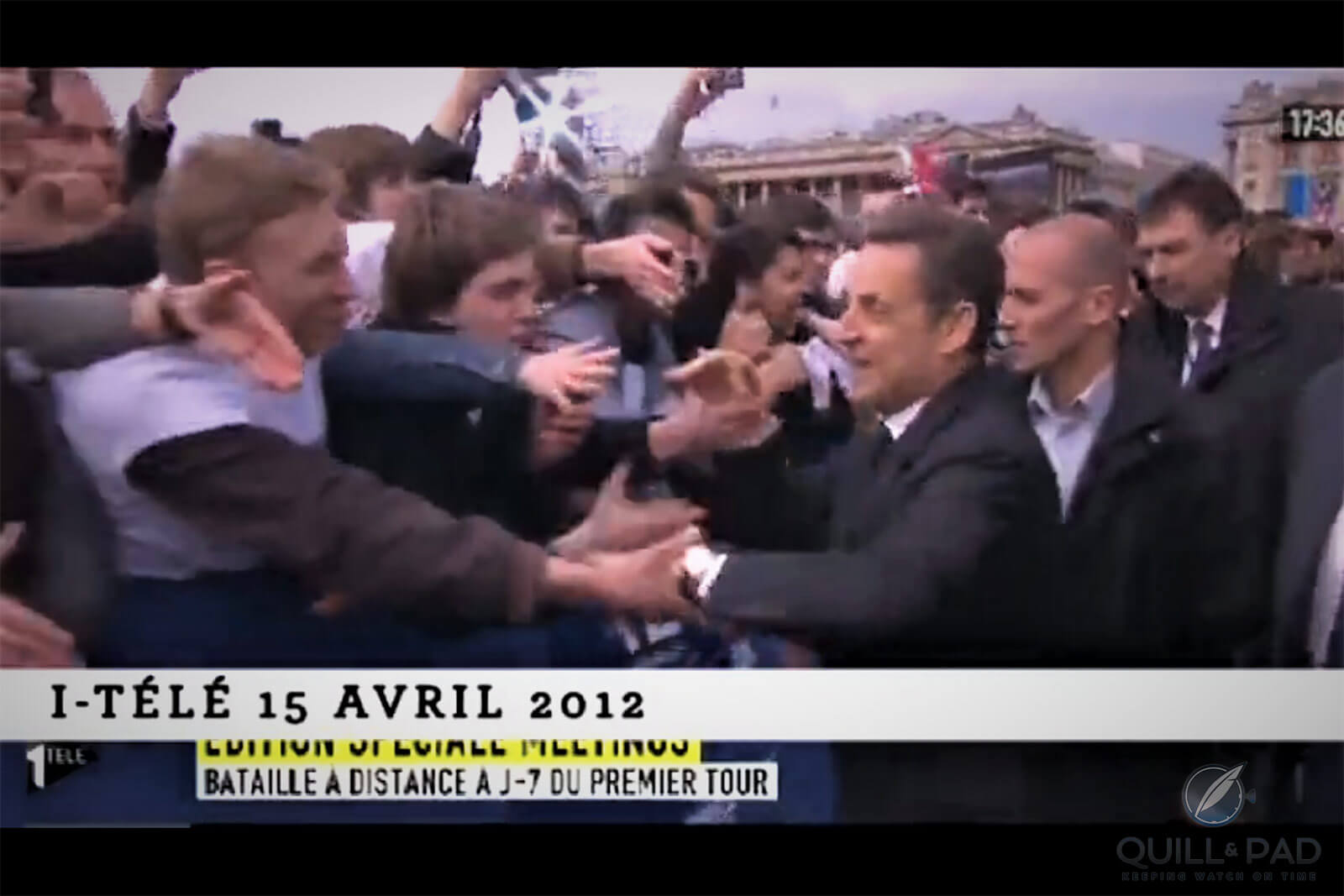
Attempted theft of Nicolas Sarkozy’s Patek Philippe on Place de la Concorde, Paris (video screenshot)
The clasp likely didn’t come loose due to the vigorous handshaking: one frame clearly shows a young man with fair hair lunging forward over the barrier, and rather than grasping Sarkozy’s hand, he has his thumb on the watch crystal, a well-known Albanian pickpocketing technique involving pinning the watch case to the wrist with the thumb while undoing the clasp with the other fingers – a method to which George Bush was reported to – though officials later denied – to have fallen victim to while meeting crowds near Tirana in Albania.
Nicolas Sarkozy was being robbed in broad daylight without his bodyguards even noticing.
With this technique, as soon as the victim feels that the bracelet has been successfully loosened, he instinctively withdraws his arm to save his watch, but the watch stays in the pickpocket’s hand. Fortunately, in this instance Sarkozy was able to save his Patek Phillipe.
Verdict: A myth. Monsieur Sarkozy is not guilty as charged.
Myth 2: the “Mirbat nine” gold Khanjar Rolex Sea-Dwellers
The second myth is one that I have to confess to having helped, at least for a time. In recent years it has become an accepted truth that “the Sultan of Oman awarded Rolex Sea-Dwellers emblazoned with gold khanjars to nine members of the British SAS who fought off hundreds of Omani rebels at the battle of Mirbat” on the southern coast of Oman in 1972. And at least one Rolex Sea-Dweller has been sold by Phillips with this description.
However there is in fact no evidence of this. The idea started life with a single article on these watches on the website of Rolex expert and dealer Daniel Bourn, Vintage-DB.com, in which he analyzed the serial numbers of known examples of the red and gold khanjar watches and conjectured, on a purely hypothetical basis, that these logo watches could have been awarded to the 90-odd SAS members clandestinely operating in Oman in the early 1970s, and the gold ones to the nine SAS men involved in the battle of Mirbat. The SAS (Special Air Service) are British troops deployed in special situations.
In my Quill & Pad article Khanjar And Qaboos Rolexes: Are They The Vintage Watch Industry’s Blood Diamonds? I quoted the Vintage-DB website as follows, “Given that the Battle of Mirbat was a pivotal moment in defeating the insurgents, and the lack of recognition given to the SAS soldiers by their own government, it is not inconceivable to think that Qaboos who had previously commissioned the Red Oman watches to commemorate the SAS soldiers who occupied Oman during the 1970-1976 campaign would commission a small special batch to honor the nine SAS troops who put their lives at risk during the Battle of Mirbat to defend Oman from the rebellion.”
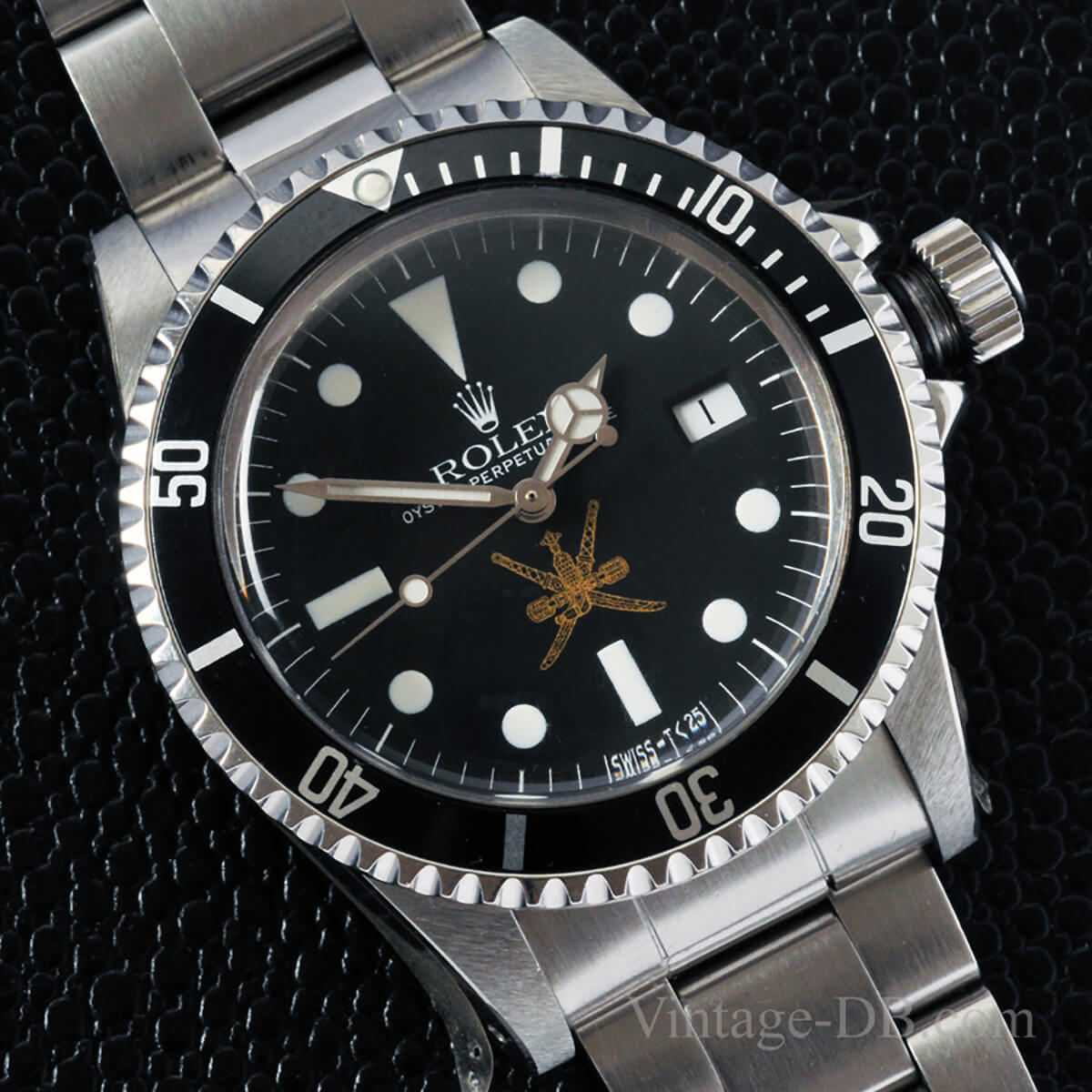
“Gold” (referring to the color of the Omani emblem) Rolex Khanjar Sea-Dweller (photo courtesy www.vintage-db.com)
Like the lost text identified by Bible scholars as “Q” (for Quelle, “source” in German), the inspiration behind the Gospels of Matthew, Mark and Luke, thus it was that the Vintage-DB website became the unintended “Q” of the Khanjar Rolex Sea-Dweller myth.
Following Quill & Pad’s publication of my Khanjar article in December 2019, a flurry of articles on Khanjar Rolexes and other watches appeared in the online and offline press, especially after the death of Sultan Qaboos in January 2020, many of which clearly drew on my article and on Daniel Bourn’s website.
For example, where my article states “this number might correspond to the nine SAS members who took part in the battle of Mirbat on 19 July 1972,” in its May 2020 article on Khanjar Rolexes, GQ magazine stated, “Recipients of these special pieces included members of the British Armed Forces, which helped the Sultanate consolidate power from the 1950s onwards. Of particular note are those presented to SAS soldiers for their help in quelling the Dhofar uprising in the 1970s.”
This highlights how a simple but attractive hypothesis very quickly morphs into fact in the mainstream media, which is in turn quoted by watch dealers and auctioneers in their product descriptions in order to drum up interest and boost prices. The circle becomes self-fulfilling.
Perhaps the parties concerned should have read to the end of Daniel Bourn’s article, where they would have read: “Of course, without official delivery information from Rolex, Qaboos, or the surviving SAS soldiers, we cannot be certain, but the theory should encourage further discussion, research, and understanding of the events in Oman during the 1970s and the important watches that commemorate the period.”
In separate confirmation of this, I asked a contact at Phillips as to whether they had handled any Khanjar Rolexes consigned by former SAS members, to which the reply was that they had sold a Khanjar Sea-Dweller but, “we only had one, consigned by the son of the original owner, but the latter was not part of the SAS.”
Furthermore, I was contacted by a London-based watch collector who had bought one of the supposed “SAS” Khanjar Sea-Dwellers and, out of curiosity, tracked down one of the SAS operatives who had actually been at Mirbat. He told me that the SAS man “laughed incredulously and replied categorically that neither he nor his colleagues received any recompense of any sort for their role in that battle, let alone a Rolex . . . ”
Myth 3 (also featuring the illustrious coronet): Sir Edmund Hillary and Tenzing Norgay were wearing Rolex watches when they reached the peak of Mount Everest in 1953
Sir Edmund Hillary and Tenzing Norgay wearing Rolex watches while summiting Everest is a dual myth that needs to be doubly scotched. No ice.
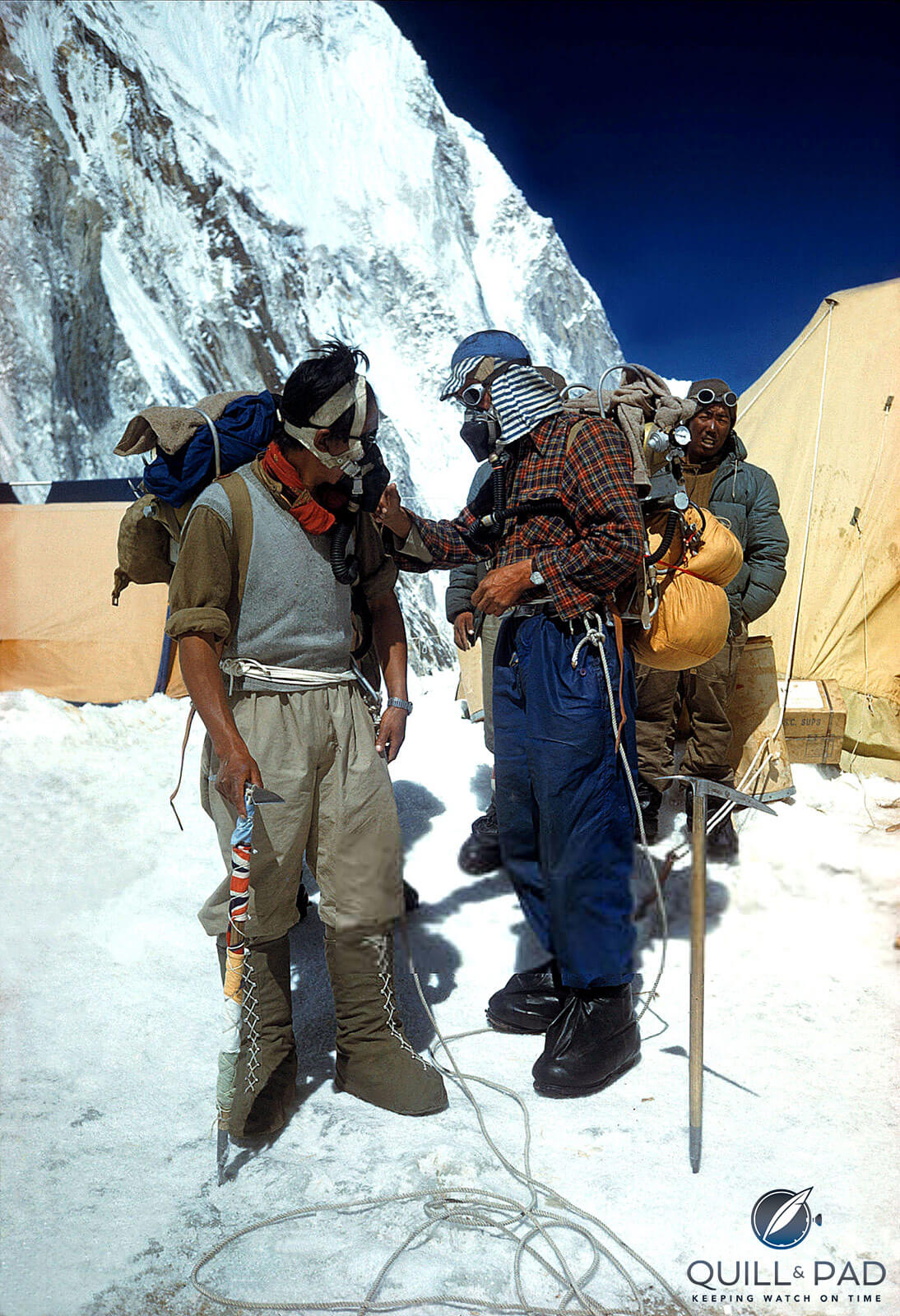
Tenzing Norgay (left) and Sir Edmund Hillary on Mount Everest Everest, both wearing watches (photo courtesy Royal Geographical Society)
The first part is easy: it is frequently claimed that Hillary and Tenzing were wearing Rolex Explorers on their conquest of the peak, or at least some form of “pre-Explorer.”
It has been clearly documented that the 1953 team led by Sir John Hunt was equipped with 13 watches from Rolex: six given to team members who had been on the previous year’s unsuccessful Cho Oyu expedition and seven for the new members of the 1953 team.
But as collector James Dowling explains in his article in the final issue of the now-defunct QP magazine, these watches were standard Rolex Oyster Perpetuals, not Explorers, as the Explorer model with its distinctive 3-6-9 dial was still in development and would not emerge in that form, with or without the Explorer name on the dial, until later in 1953. The famous Mercedes hands would not be added for another 18 months.
The second aspect of the myth is more controversial and has remained so for many years due to lack of clear photographic or written evidence. Particularly the absence of a categorical statement either way by the persons concerned or by Rolex itself. The myth perpetuated to this day by numerous print and online publications, some of which ought to know better, and backed up by a stream of almost subliminal advertisements by Rolex, is that Sir Edmund Hillary was wearing his Rolex Oyster Perpetual when he reached the peak of Mount Everest on May 29, 1953 accompanied by Sherpa Tenzing Norgay.
Sometimes the myth is extended to include Tenzing Norgay as well, claiming that he was wearing the gold Rolex Day-Date given to him by mountaineer Raymond Lambert on the Swiss Everest expedition in 1952.
For example, the following publications categorically claim that Sir Edmund Hillary was wearing a Rolex Oyster Perpetual at the peak of Everest.
Hodinkee.com: FOUND – The Rolex Sir Edmund Hillary Wore To The Peak of Mount Everest states: “In 1953, the not-yet-Sir Edmund Hillary became the first man to summit Mount Everest along with expedition partner Tenzing Norgay. And he did so with a Rolex on his wrist, an Oyster Perpetual that would prove to be the ancestor of the Explorer.”
The Watch Book Rolex by Gisbert Brunner, published by now-bankrupt TeNeues, states authoritatively that, “When Edmund Hillary glanced with a mixture of relief and joy at his wristwatch on May 29, 1952, its dial showed 11.30 A.M. . . . Like all other members of the official expedition, he had picked up his watch two months previously in Jaynagar, an Indian city along the border with Nepal, where it had been sent by Geneva-based Montres Rolex S.A.”
Phillips Hong Kong watch auction XI, November 29, 2020: “The story of the Rolex Explorer was really made when it was the very first wristwatch worn on the summit of Everest by none other than Sir Edmund Hillary and his Sherpa Tenzig [sic] Norgay.”
Online retailer analogshift.com gets it even more muddled: “The Explorer traces its heritage back to the first successful summit of Everest in 1953. While we know now that the watch on Sir Edmund Hillary’s wrist was a Rolex Oyster Precision. The Oyster Precision was the precursor to the Explorer, and it was the Precision that introduced the 3-6-9 Arabic dial that we associate with the Explorer today. It was after the successful summit that Rolex rechristened the model as the Explorer in honor of Hillary and Norgay’s historic accomplishment.”
So it is hardly surprising that, like the mist that shrouds the peak of Kanchenjunga for much of the year, the truth of the matter is shrouded in myth, which is in turn enveloped in nonsense. And the key to this mystery is encapsulated in that last sentence: “It was after the successful summit that Rolex rechristened the model as the Explorer in honor of Hillary and Norgay’s historic accomplishment.”
If Sir Edmund Hillary was wearing a Rolex (of any sort) at the summit, why didn’t Rolex re-issue a Rolex Everest in celebration of the fact, just as French watch manufacturer LIP did with its LIP Himalaya after Maurice Herzog’s conquest of Annapurna in 1954?
And why did a now-defunct English watch manufacturer by the name of Smiths issue a Smiths Everest in 1953?
Furthermore, when I interviewed professional diver Nigel Band about his father George’s Everest and Kangchenjunga Rolexes, he described attending a Royal Geographical Society talk given by Sir Edmund Hillary in the 1970s, where he overheard one of the regular society members leaning over to another member and muttering “of course it wasn’t a Rolex he was wearing at the top, it was a Smiths . . .”
Definitive answer to the Hillary/Tenzing/Rolex/Smiths controversy
Several commentators and bloggers have tried to find a clear-cut answer to this question, but after combing through all the available photographs, advertisements, and correspondence, they have usually failed to come up with a concrete answer addressing all the issues and have generally restated whichever myth they prefer to believe.
However, a definitive answer has finally emerged from outside the self-perpetuating smoke and mirrors of the watch-collecting world: an article published by outdoorjournal.com describes the background to the supplying of the expedition team with watches and other equipment, producing categorical evidence that not only resolves the matter once and for all, but ties up several loose ends and explains Rolex’s rather curious advertising strategy with regard to the Explorer model ever since.
The article can be found here, but the facts can be summarized as follows:
- Rolex was an early adopter, if not the inventor, of product placement. It had therefore already been supplying various mountaineering expeditions with a view to the publicity that would be gained by having its watches on the wrists of whoever was going to conquer Everest one day.
- Smiths was a British instrument company that had been canny enough to supply the Everest team with a range of equipment such as altimeters and oxygen regulators in addition to its watches. In return, it extracted a promise from the mountaineers that they would wear their Smiths watches to the summit.
- Rolex jumped the gun on June 2, after Times journalist James (subsequently Jan) Morris’ coded message announcing the conquest reached London, by publishing a full front-page advertisement in the Times that featured a picture of an Oyster Perpetual captioned, “The Rolex Oyster Perpetual that reached the top of Everest on May 29th.” However, this is the last advertisement or communication of any kind in which Rolex categorically claims that one of its watches had been at the top with either Hillary or Tenzing. Morris’ message did not indicate what watches they had been wearing. Interestingly, Smiths Watches placed a modest congratulatory advert on June 2 as well, followed on June 3 by a much bolder, self-congratulatory celebration of the fact that its watch had conquered Everest.
- Even though Rolex subsequently had Hillary, Hunt, and Tenzing on the payroll as brand ambassadors, the ensuing advertising is non-committal and confusing. Testimonies by Hillary and Hunt quoted in Rolex advertisements (“I wore the watch continuously, day and night”) refer to the previous year’s Cho Oyu expedition or merely praise Rolex watches in general terms.
In a typical example of this, the first advertisement for the Rolex Explorer features a drawing of two mountaineers ascending a ridge (with some way to go to the top) and a testimony from Sir John Hunt, signed on June 15, 1953, to the effect that, “Our Rolex Oyster Perpetuals were completely waterproof, unharmed by immersion in snow, and withstood the extreme change in temperature from the warm humidity of the foothills to the great cold of the higher camps.” No mention of the cold at the peak, you will note. The ad also features a picture of a black-dial Explorer, which is probably at the root of the “Explorer conquered Everest” myth. Again, circumstantial evidence but nothing that would stand up in a court of law.
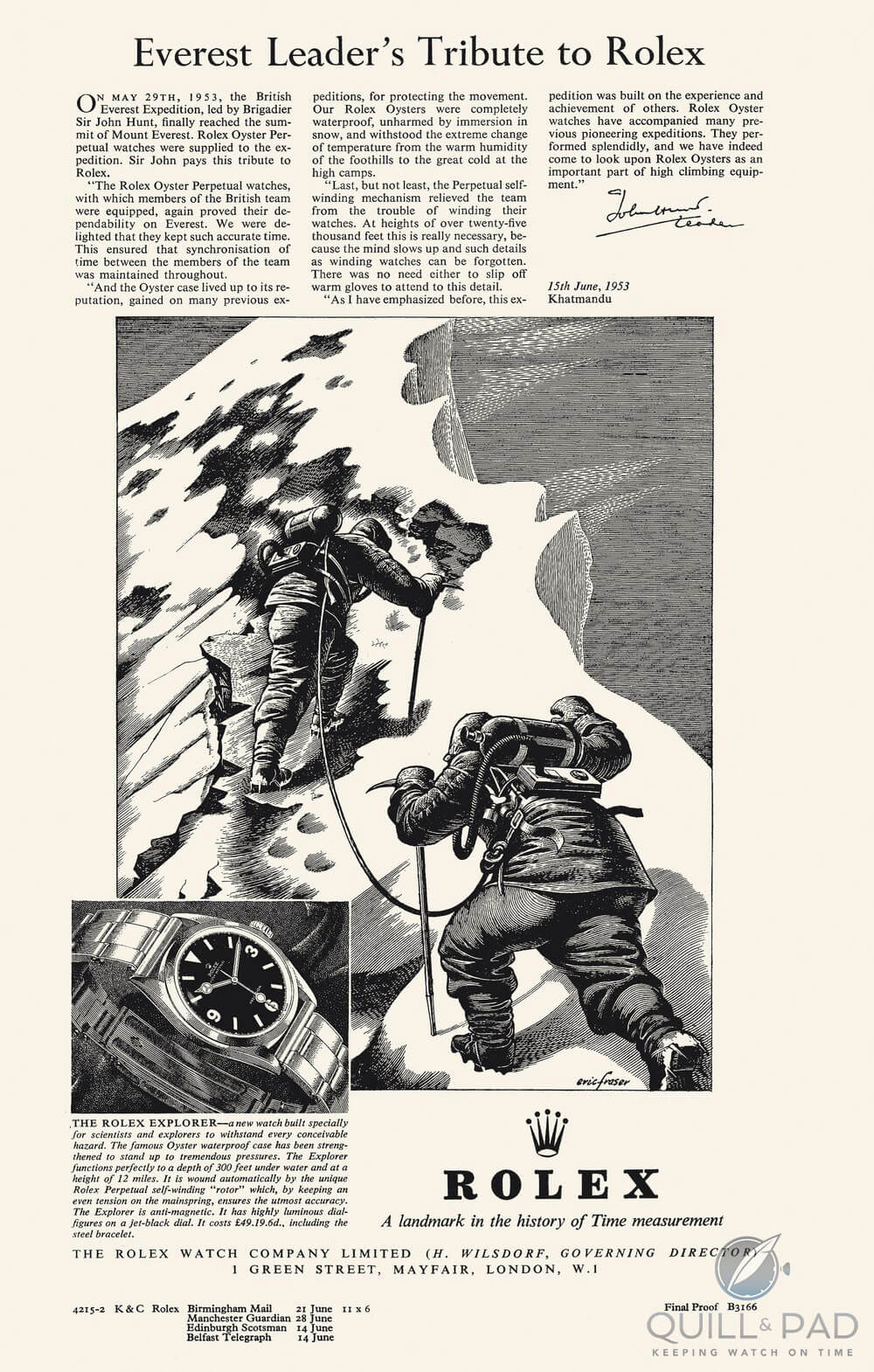
The root of the Rolex Explorer/Everest myth (historical advertisement courtesy Rolex)
In the end, it is a somewhat heated exchange of correspondence in the Journal of the British Horological Institute (as people used to do in the days before flame wars on internet forums) that categorically settles the matter.
In one letter, the managing director of Smiths English Clocks Ltd, D.W. Barrett, wrote: “Our watches, and certain other Smiths equipment including oxygen gauges, were supplied and we received a written assurance that the watches would be worn to the ultimate point reached on the mountain. Sir Edmund Hillary has stated in writing that he took a Smiths watch to the summit and no other . . .”
To which Mr. R.A. Winter, director of Rolex Watch Co., Ltd, of Mayfair, London, replied: “We supplied Rolex Oyster Perpetuals for all members of the British Mount Everest 1953 Expedition, but if by a fortuitous chance Sir Edmund Hillary’s watch did not reach him or if he was not wearing it in his ascent of the last few hundred feet, then we regret that our first advertisements in connection with Everest suggested the contrary, although we had every reason to suppose that he received his watch.
“It would appear from Mr. Barrett’s letter that Sir Edmund Hillary was, in fact, only wearing one watch at the summit and that a Smiths watch. We congratulate Smiths on the fact that their Smiths Deluxe ordinary wind wristwatch reached the summit with Sir Edmund Hillary.”
Let’s just read that again: “Sir Edmund Hillary was, in fact, only wearing one watch at the summit and that a Smiths watch.”
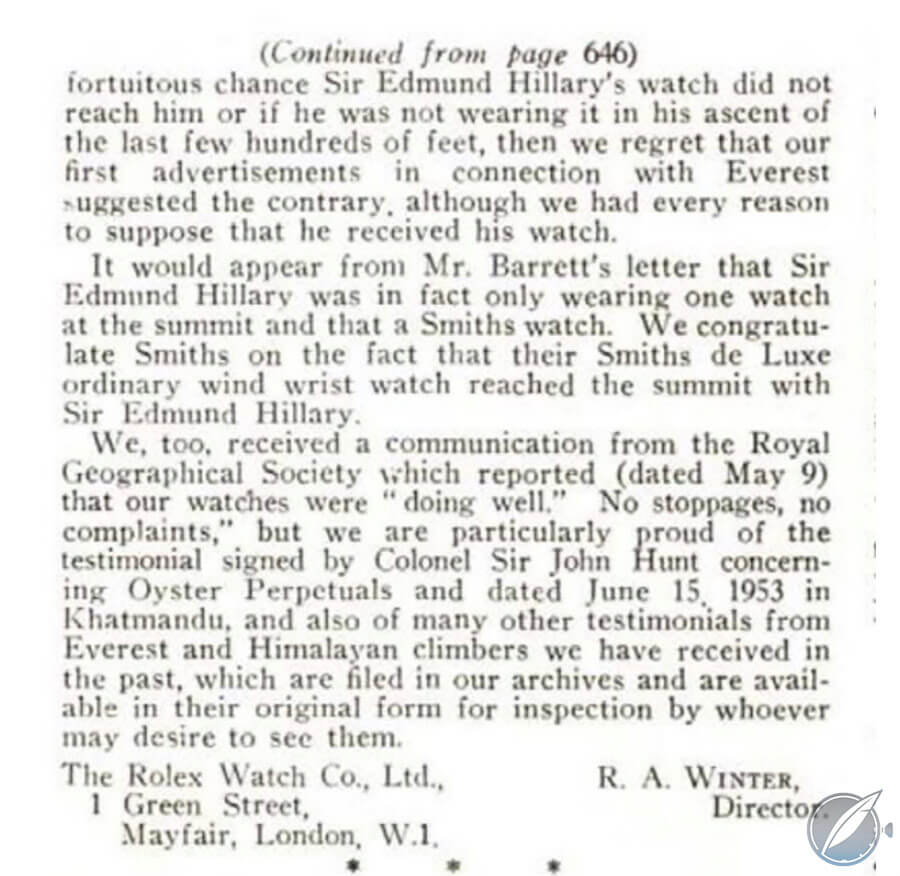
Reproduction of the BHI Journal page on Edmund Hillary’s Everest wrist wear (photo courtesy www.outdoorjournal.com)
Everything that Rolex subsequently produces in terms of advertising and communications is hamstrung by the fact that although 13 Oyster Perpetuals did go up Everest on that expedition, including two on the wrists of Charles Evans and Tom Bourdillon, who made the first attempt, turning back just 70 meters from the peak due to oxygen problems, none of them made it to the top. Now that we know this for sure, Rolex’s marketing of the Explorer model and all the subsequent advertisements make sense.
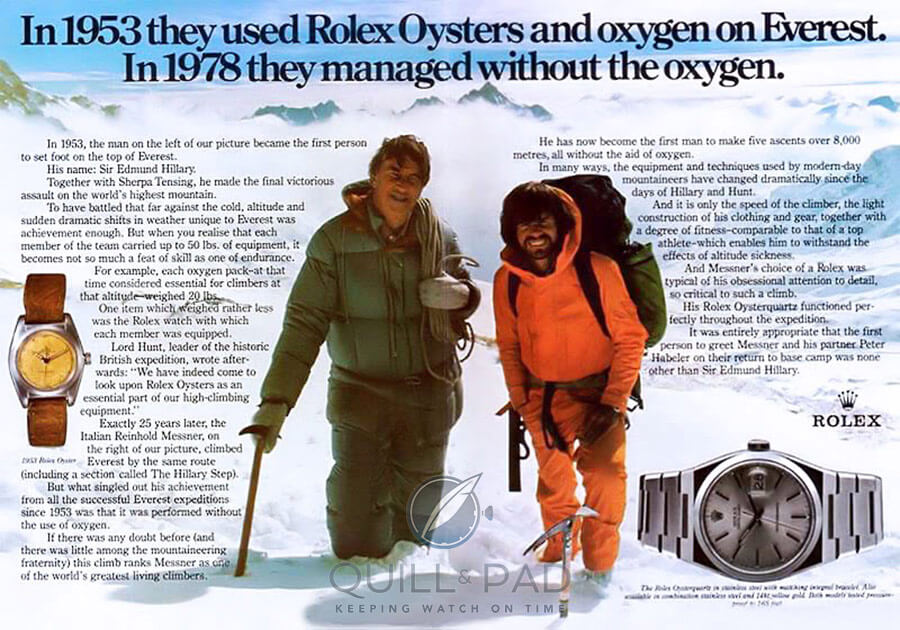
Rolex advertisement featuring Sir Edmund Hillary, which at no point states that he was wearing a Rolex at the summit of Everest (historical advertisement courtesy Rolex)

More subliminal Rolex advertising
Smiths, however, stakes its claim in no uncertain terms, even though its advertisements look amateurish in comparison to Rolex’s. Some have commented that Hillary’s statement that he “carried” a Smiths watch to the summit indicated that he wasn’t wearing it and must therefore have been “wearing” his Rolex on his wrist.
I initially thought the same thing, but have since then read several descriptions, written in the mid-twentieth century, of men “carrying” a wristwatch. Given that a gentleman carried rather than wore a pocket watch, and wristwatch production did not overtake pocket watch production until the 1940s, it is quite plausible that a man of Hillary’s generation, in a surviving vestige of common English usage, would speak of “carrying” a watch rather than “wearing” it.
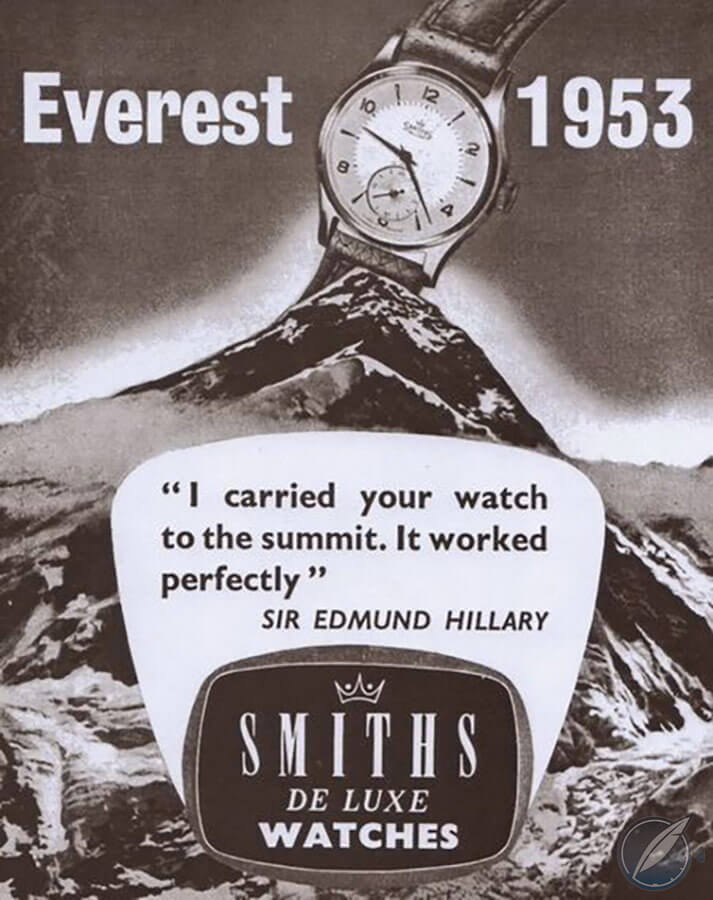
Smiths’ Everest advert (photo courtesy www.outdoorjournal com)
In any event, the Smiths watch that Sir Edmund Hillary wore to the peak of Everest is now on display in the London Science Museum.
As for the watch that Norgay was wearing, the received wisdom is that he was wearing the engraved gold Rolex Datejust given to him by mountaineer Raymond Lambert after the previous year’s Swiss Everest expedition.
However, none of the numerous photographs of him on the 1953 expedition show him wearing a gold watch. All of them clearly show a steel watch on a Bonklip “bamboo” bracelet, the type that came on the ubiquitous army issue West End Watch Co Sowar model issued to Indian and British soldiers in India for much of the first half of the twentieth century – and as would certainly have been worn by Gurkha regiments in Nepal.
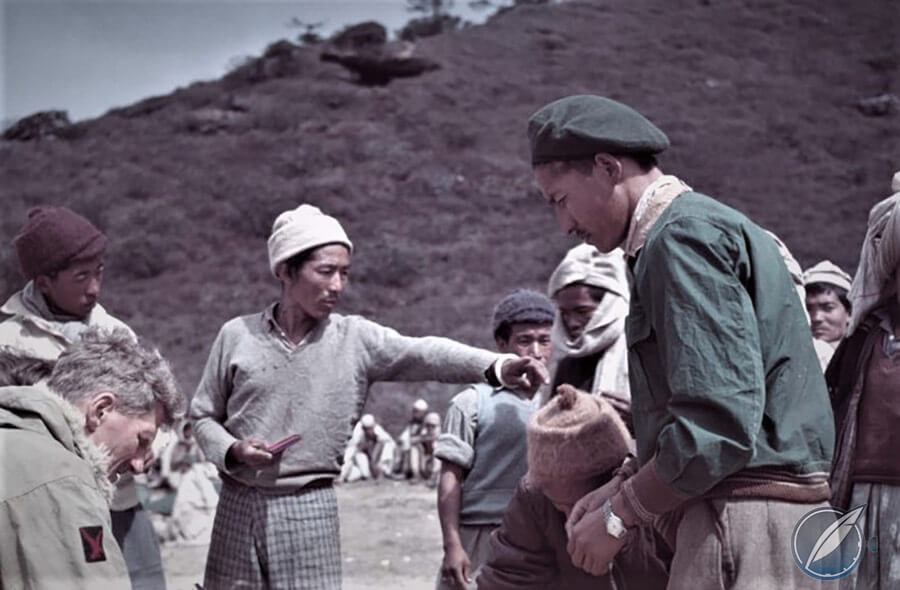
Tenzing Norgay wearing a steel watch on a Bonklip bracelet early in the 1953 Mount Everest expedition (photo courtesy Royal Geographical Society)
As you may be aware if you read my article The Grail Of Attic Finds: Reunited With The First Watch I Ever Owned, A West End Watch Co Sowar Prima, I am a fan of the Sowar and I would be delighted to think that Sherpa Tenzing Norgay was wearing one at the peak of Everest. Perhaps it was one of the Smiths Deluxes lent to the expedition, put on a Bonklip bracelet as Tenzing would have been aware of the strength, easy adjustability, and extreme comfort in hot weather of these rather unassuming-looking bracelets.
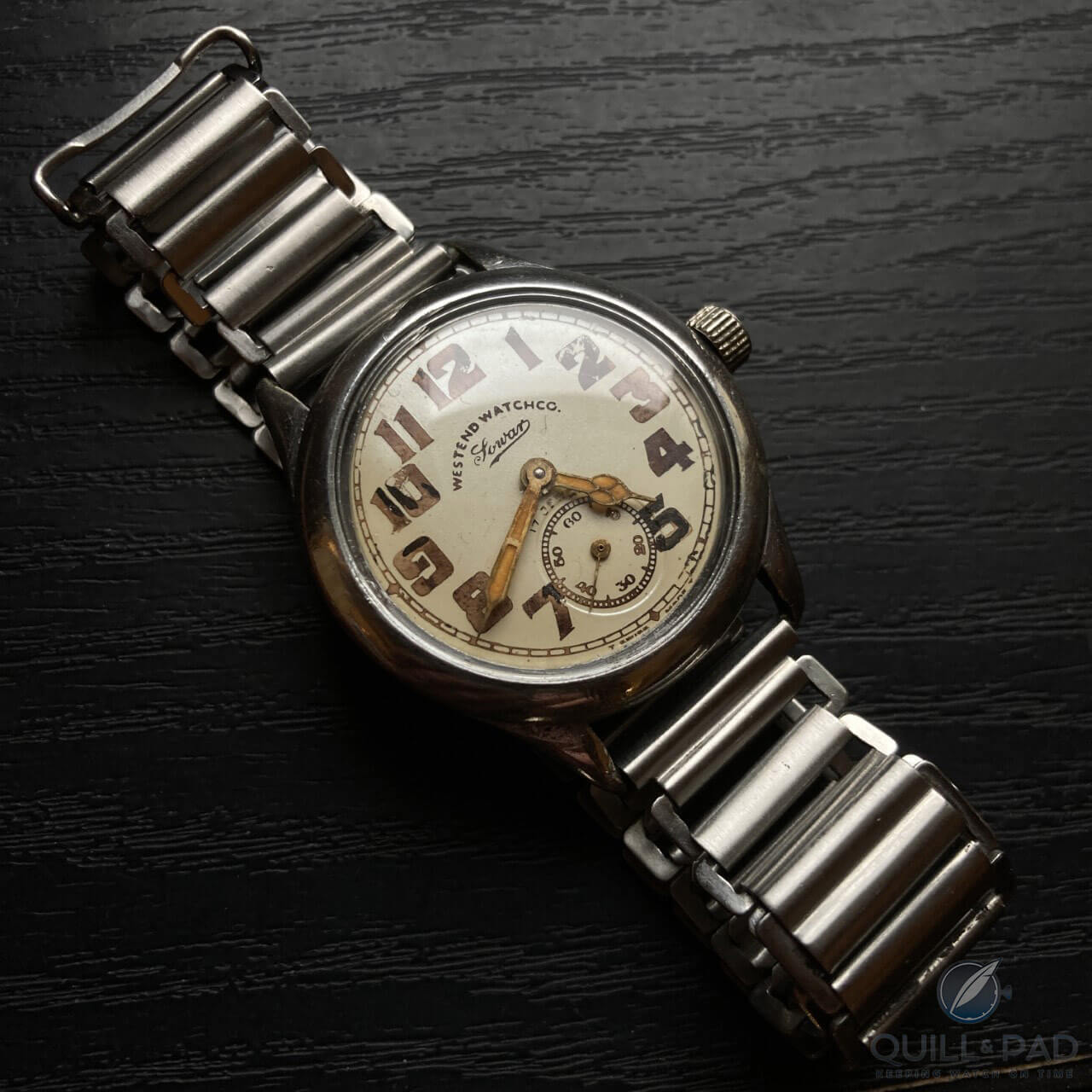
Typical 1940s West End Watch Co. Sowar on original Everbright bracelet, ubiquitous in India during this period – this example was found in Pakistan (photo courtesy Colin Alexander Smith)
If it was a Rolex, the brand would have established this fact when it debriefed future brand ambassadors Hunt, Hillary, and Tenzing after the descent and would have exploited it to the fullest. In any event, only 13 Oyster Perpetuals were supplied by Rolex to the Everest team for the 1953 expedition, and at that point Norgay did not count among the original 13 team members.
So there we have it. Rolex eventually acknowledged in writing that Sir Edmund Hillary was wearing his Smiths Deluxe, and only his Smiths, at the peak. And although Tenzing Norgay owned a gold Rolex given to him by Raymond Lambert in 1952, there is plenty of evidence in the color photographs of the Royal Geographical Society archives that he was not wearing it at any point on the Everest mission.
Unless somebody has evidence to the contrary . . .
You may also enjoy:
Hello, Newman: A Collector Looks Askance At The Cult Of The Paul Newman Rolex Daytona
Khanjar And Qaboos Rolexes: Are They The Vintage Watch Industry’s Blood Diamonds?
Leave a Reply
Want to join the discussion?Feel free to contribute!



Fantastic write up! The Smiths/Rolex mystery has always intrigued me. Great to have an answer.
Thanks Erik, glad you enjoyed it!
Fascinating.
Something of Link and Bunnage’s Modern Toss to your art style, btw.
I owe my mastery of line and form to Spike Milligan, Gav. I suspect Link and Bunnage do too.
Thank you for showing that Rolex is all marketing and just a very ordinary watch. The marketing makes the price what it is and of course false scarcity.
To be honest Ray, Rolex have little to be reproached for, it’s the fans that create and perpetuate the hype. If I I was going up Everest I would rather be wearing an Oyster Perpetual than a Smiths – and my name is Smith!
I think I disagree.
Often when someone is self-consciously doing something naughty that is plausibly deniable it is not individual actions but patterns of behaviour that give away what is really happening. In this case, it appears obvious to me that Rolex are abusing the conventions of conversational implicature. This might sound like an arcane bit of philosophy, but it describes a principle that cuts right to the heart of honest communication.
It is perfectly true that, after 1953, Rolex never explicitly claim that there was a Rolex on the summit of Everest. So far, so good. However, their advertising consistently leads people to the point at which it is a perfectly reasonable and rational inference to assume that there was a Rolex on the summit of Everest.
This is achieved in acts of commission: very carefully phrased adverting copy, brochures and press releases that take the reader to the edge of an inference but stop short of making it.
However, it is also also in acts of omission. Points at which Rolex could, straighten the record. Lord knows, they have enough to be proud of without taking the credit for things they didn’t do.
I’m unclear why Rolex do not take a more active and leading role in the history of the brand. There’s a hunger for real history out there and it is poorly served by an ill informed echo chamber. That Rolex choose to let falsehood circulate is not in the spirit of Wilsdorf’s founding charter. Wilsdorf was deeply concerned with ethical continence and the Hans Wilsdorf Foundation’s founding document is explicit that part of their ongoing role is: “to ensure that their operation is in the spirit and traditions of their founder”.
I will not be at all surprised that Mr Downing, as he realises that his ‘definitive proof’ is built on sand, will realise that at no time was he actually told by anyone from Rolex that the watch he has seen was worn by Norgay on the summit. I know that a decade ago, Dowling claimed in the Telegraph that both Hillary and Norgay were wearing Rolex based on exhibits in two Swiss Museums.
https://kaleistyleguide.com/luxury/watches/rolexs-spirit-of-adventure/
Clearly his mind has been changed about the Beyer Rolex. Perhaps he might wish to consider why no one at Rolex, chose to hint to him that the Beyer watch wasn’t in fact the real thing? It’s impossible to believe that they didn’t know.
Rolex have no official museum and won’t do the “extract from the archive” service that others (e.g. Omega and Longines) do. They are secretive — helped by the opacity created by their ‘charitable’ status. From HQ to AD they act in a high-handed and elitist way, maintaining The Myth (and perpetuating the myths) of what is, essentially, another Veblen brand.
Cry us a river. If you want a Rolex just say it.
Dear Colin, great pleasure to read your article. It shows us one side of the coin and the enormeous efforts of brand- and marketing-managers to create myths (the winners and the losers). The other side of the same coin are the buyers, the collectors, the admirers – we. We are snobs. We like to have unique pieces in a world of mass production. So we create stories about special and unique watches and connect the objects to important events … to enjoy some extra shine on the object or on ourselves (and to boost some extra value). If it is only a Doxa (with an ETA 2931) we do not care a thing about it. Greetings and thank you very much, Thomas.
I LIKE my DOXA and its ETA 2391, Thomas!
The DOXA is perfect and much nicer than all fancy mystic hype watches.
With all this publicity its value is rising day by day, Thomas. I am open to reasonable offers.
I have definitive proof about Tenzing Norway’s watch on Everest. Feel free to drop me a note
I am delighted to see that Mr Dowling, undoubtedly one of the world’s authorities on Rolex sports watches has “definitive proof about Tenzing Norgay’s watch on Everest”. However, I would argue that asking folk to ‘drop him a note’ is possibly not the best way of establishing the facts of the matter. Better by far, surely, to make his case publicly where it can be assessed and discussed first hand.
I am aware of the forties bubble-back apparently held in the Rolex Museum that Mr Dowling has argued elsewhere is the watch worn by Norgay on Everest. I’m unsure if he has changed his mind since he most recently made the claim, but I’m sure he can confirm this either way.
To be clear, Mr Dowling’s work on Rolex is as close as it can get to definitive and, if I hadn’t spent so much time on doing my own independent research, I’d certainly be accepting his word as gospel. However, perhaps there has been a little too much deference and, in the echo chamber of the internet, it would be nice to see arguments and evidence tested publicly.
Apart from anything else, I am quite certain that this
https://forums.timezone.com/index.php?t=msg&th=1487153&rid=0
forties bubble-back is not the watch worn by Norgay on Everest.
It is not the watch because the watch in the museum is an earlier model to those supplied by Rolex to Lambert and wasn’t even a current model in 1953. It is not the watch because Lambert’s original expedition watch is still owned by his son and it is not the watch because the clearest RGS pictures of the expedition are unambiguously not of a small early bubbleback. They are unambiguously a Smiths.
Finally, If Rolex had held the watch in their museum, the conversation between Barrett and Winter in the BHI journal may have gone very slightly differently. As would my earlier argument.
The only reason the question isn’t also definitively solved in the Outdoor Journal article is that the RGS were not able to give me timely permission to use a couple of clear, but unpublished, images from the physical RGS collection.
Had they been able to, the article would have been a little longer and would have tracked Norgay’s watch up and down the mountain in a mixture of monochrome and colour images. While the colour images from the final assault are clear enough to rule out a gold Datejust – or a forties bubble back of around 30mm. They are, however, not quite clear enough to unambiguously identify the precise watch. The black and white images are.
So, unless Mr Dowling has solid evidence that the watch is a Smiths, I suspect that his definitive proof is likely to struggle in the cold light of day and end up in the same position of many other definitive proofs.
Now that’s a strong claim, and I rather expect it to be tested…
Surely if Rolex had had one of their watches on the summit in ’53 they would have made as much noise about it as Omega did with the moon? Yet all the Rolex adverts and publicity material is remarkably coy and circumspect. I wonder why?
I think the question is asked – and definitively answered – in the article, Oliver!
You mention that ‘Smiths was.. canny enough to supply a range of equipment such as altimeters and oxygen regulators’. In Sir John Hunt’s The Ascent of Everest (I have my dad’s Companion Book Club copy) there is an appendix listing the companies and organisations associated with the expedition and what they supplied. Smiths Clocks Ltd are credited with alarm clocks and watches. There is no mention of oxygen regulators – Oxygen equipment is shown as supplied by Barnet Instruments, BOAC, Dunlop Rubber Co., Harcourt, David Ltd., Normalair Ltd. and various government departments, regulators are specifically mentioned as having been supplied by Seibe Gorman and Co. Altimeters were supplied by the Met Office – did Smiths even manufacture altimeters? I’ve never seen one. Seems like you are debunking one myth and feeding another!
More importantly, just in case a slick marketing department somewhere tries to claim otherwise, it is categorically stated that the string vests were supplied by Courtaulds. And the tea was Typoo.
Hello Simon,
Smiths Watches was a minor division of the Smiths group at the time and the watches were part of a package.
If you read the Outdoorjournal article, Smiths MD wrote to the BHI saying “With reference to Mr. C.E. Faller’s letter which appeared in the August issue of the Horological Journal, in which our name was mentioned, I would say that advertising is one thing and fact another. The facts as we know them are that the committee of the British Mount Everest Expedition indicated that in many ways the expedition was to be a national enterprise and the aim would be to equip it entirely with British goods. Our watches, and certain other Smiths equipment including oxygen gauges, were supplied and we received a written assurance that the watches would be worn to the ultimate point reached on the mountain.”
On the altimeters, Simon, I recently read comment on a timezone post by a pilot saying “I hope the Smiths altimeters supplied for Everest were more reliable than the one in my Cessna!” So they must have made those at some point too.
In fact, a quick Google does indeed show various pressure instruments (altimeter, rate of climb and descent indicator, etc) having been manufactured by Smiths. I guess the ones for the expedition supplied via the Met Office could well have been Smiths. The comment from the Cessna pilot reminded me of a comment from an MGA owner in California, who said the standing joke at his British vintage car club was ‘Why is English beer warm? Because English fridges are made by Lucas’.
Someone needs to tell Philipp Stahl at Rolex Passion Report about the letters in the BHI. (There are, after all more letters in “BHI” than in “BS”.)
I believe certain parties present here did, but were ignored/dismissed. Another well-intentioned but misleading site is ‘Jake’s Rolex blog’.
Philipp Stahl does provide useful information regarding the Tenzing steel bubbleback and gold datejust, from meeting Raymond Lambert’s son. Rolex’s claim to James Dowling that Tenzing was wearing the bubbleback is undermined by the RGS archives, which consistently show him wearing a bonklip bracelet. According to James Dowling, the bubbleback was still on the leather bracelet when he saw it. Unless Tenzing was a dab hand with spring bars and watchmaker tools at -20degC….
To be fair, straps / bracelets come and go. I don’t know when the bubbleback arrived at Rolex; it might have been a while afterwards and the strap changed in the meantime.
However, I think (might be wrong) that in ’53 Tenzing did have a Rolex: the gold DJ given to him for his work with the Lambert’s Swiss expedition the previous year. Where / when / from whom did he get a stainless steel bubbleback for the 1953 Hunt expedition?
Stahl writes:
“Tenzings wife back then advised him not to take his Rolex to this 1953 Expedition. So again, after Lambert convinced Tenzing to join the British, he now had to make sure Tenzing was wearing a Rolex. I asked her why her husband was so pertinent… She explained to me that Raymond was in full believe Rolex, as genevan based, deserved it to be worn on top of a succesful ascent!
In honor of his friendship Tenzing decided to please Lambert, and did not take the “schmutz” she continued!
At first I thought, what’s a “schmutz”, so I asked her…she said her husband always said it like this to her. As we where talking german, the coin dropped and from “schmut”(German for dirty;)I explained her it was Smith, lol! 🙂”
This says that Tenzing had a “Smith” (sic) *before* the 1953 Expedition. How?
As I said, he might well have had a Rolex from the Lambert’s 1952 attempt, but Smiths had never sponsored or equipped an Everest team before they gifted the 13 watches (and 4 travel alarms clocks!) to the Hunt expedition.
13 wristwatches. Remember that number. Because there were 13 members of the Hunt party (Hunt, Evans, Band, Bourdillon, Gregory, Noyce, Pugh, Stobart, Ward, Westmacott, Wylie, Hillary, Lowe).
I reckon that is one Smiths watch per man, given in early 1953 or at a push late ’52.
So how Stahl reckons Tenzing had one *before* he joined the party is a mystery to me. In fact, unless one of the 13 gave or lent him theirs during the expedition he never had one at all.
I doubt I can find it again, Oliver, but I am pretty sure I saw just yesterday a photo of the Smiths Clocks and Watches invoice dated July ’53 for 15 watches and 4 alarm clocks. Some time after the event, which suggests the team kept the gear and was billed for it.
13, not 15.
And probably post-dated for inventory purposes. Or done pro forma “for the record” (literally!)
You’re right Oliver it was 13. What happens when you peer at things on a phone.
I’ve got lockdown eyes!
Maybe drop Stahl an email with a link to this?
I’m sure he’s a reasonable man and can contribute and/or change his mind. The letter from Dickie Winter is pretty conclusive to my mind but maybe he can gainsay it?
The problem with Stahl is that while he may well provide useful information, some of it is claims like: “John Hunt came with a message from the young UK Queen in spe to Raymond in asking him to convince Tenzing to join!. Quite apart from the historical documents that show clearly that Tenzing was asked to go by JIll Henderson, then secretary to the Himalayan Club, the idea that The Queen would be worrying about the minutiae of an, at the time, fractious and unhappy expedition, is ridiculous. Likewise, I’m curious as to where Tenzing is meant to have got the ‘schmutz’ that he declined to take on the expedition.
On the contrary, the soon-to-be Queen and Head of the Commonwealth was already a canny operator – ‘woke’ before her time, even, and would have taken a great interest in the composition of the ’53 team. Not for nothing is she the longest reigning British monarch. The official invitation may have come through the Himalayan Club but she would have been keen to see a team that reflected the member countries of the entire Commonwealth rather than just Oxbridge and the British Army.
I have photographs of my brother and me attending the wedding of some Sandhurst officer type in full regalia and his blonde bride in Borneo in 1967. On leaving the church the happy couple passed under an arch of swords held aloft by Gurkha officers and were regaled by a full Gurkha pipe band. Even 20 years after India’s independence, that whole ‘master and servant’ thing was still going on in Britain’s former territories, and the Everest expeditions were fraught with tensions such as the Katmandu incident when the Sherpas were made to sleep in the British Embassy garage. Accounts of the expeditions of the period refer continuously to the “Sahibs” and the “Coolies”. So I can quite believe this claim, which would otherwise be almost too strange to be a fabrication.
I’m afraid that the argument you are trying to make is slightly undermined by the fact that there are several parts to my article which I haven’t published. I’m sure that you will understand that I’m not entirely delighted that you have produced this homage to my bn89ÍÓÚ|
So you are saying that people should not cite comments that you have published, but rather postulate on what you may, or may not, publish at some time in the future?
Regards, Ian
What I was going to say has apparently become slightly garbled somehow. I’m the author of the work published over at The Outdoor Journal and being discussed here. While I am committed to the free exchange of ideas, it would have been nice to have been consulted in advance before such an accurate reworking was produced. However, The Outdoor Journal is credited keeping to the letter, if not the spirit, I don’t think it’s unreasonable to be a little miffed, even as I get involved , no?
That said, there was an extended argument based upon a series of photographs which included several that were previously unpublished. That didn’t get used in the original article.
My point is that when Colin asserts that:
” …undermined by the RGS archives, which consistently show him wearing a bonklip bracelet. According to James Dowling, the bubbleback was still on the leather bracelet when he saw it. Unless Tenzing was a dab hand with spring bars and watchmaker tools at -20degC…”
He’s slightly missed the point. The reason that the bonclip matters is not because it’s different to any particular watch or strap combination, it is because it links all of the many photos of Tenzing’s watch throughout the expedition. He’s consistently wearing a specific West End bonclip (and Norgay served as a batman in the Indian Army’s Mountain Division). This connects the points on the expedition at which the watch is unambiguous – or reasonably clear when blown up (as in the photo above featuring Hunt and Tenzing) with the points that are historically significant such as the moments before the ascent.
Mod -feel free to delete the earlier garbled post.
After reading your article on outdoorjournal.com, Matthew, and obtaining authorisation from them to link to and quote from it, I tried to contact you through the OJ editor and even joined your little forum and left you private messages.
In the absence of any reply from you, I understood that you were not interested and went with the authorisation I had from outdoorjournal.com.
Your research deserved to be brought to the attention of the wider watch community rather than languishing on a ramblers’ magazine and a forum. Quillandpad.com is one of the leading online horological magazines, syndicated by channels such as Watchbox and Watchville alongside the likes of Hodinkee, Revolution and Worn & Wound and I am sure that your article has enjoyed a surge of hits this week following its referencing in the above article, which in any case is not exclusively about the Everest watches, it covers other myths too.
No, Matthew, crediting, linking to, condensing and summarising another writer’s longer work as part of a new, broader article is not copying in any form, nor is it sloppy journalism. It is good practice.
It’s also a bit rich given that you and your forum have been quoting, copying, cutting and pasting and generally dissecting my articles over the last four months (including a full-size RGS photo that you did not have permission to reproduce there) without the slightest nod of acknowledgment at any time.
It appears to me that you feel that you “own” this story, and (I quote) “throw an entire Toys’r’Us out of the pram” whenever somebody else encroaches on your patch.
This is a shame because a lot of people have something – however small – to contribute to this story. That does not detract from the fact that you found the “smoking gun”.
For example, I am interested to know how you determined that the Bonklip bracelet(s) worn by Tenzing is specifically a West End bonklip. I have some old West End watches with both (W) Everbrite and unbranded bracelets, and I wouldn’t be able to tell the difference from a photo.
It has been brought to my attention that you are now accusing me of plagiarism on your forum, Matt (“That’s what tends to happen when you shamelessly copy someone else’s work”). Given that I linked to your article twice, and made it clear at the relevant point in my article that I was summarising the facts put forward in your article, I fail to understand how this constitutes “shameless copying”.
Plagiarism is when you don’t acknowledge your sources. Copying is copying whether you acknowledge the source or not. You engaged in lazy journalism and you don’t appear terribly ashamed about it. Your earlier response was astonishingly arrogant and did you no favours at all.
If you want another Rolex myth, then the Oyster was NOT the first waterproof wristwatch case, contrary to the claim all over their website. Hey ho.
The trouble they are fine watches. Not the best and not worth the money (imho) but solid and serious. There’s simply no need to oversell them. Hype always hurts in the end.
My take is that both Smiths and Rolex were retrospectively asked by the RGS to provide paperwork. If you look at the physical paper work of a range of expeditions that Rolex were involved in from ’33 onwards, there’s either a very polite letter offering the gift of a few watches or nothing. More to the point, all the expeditions but the ’53 one have paperwork that is at about the level of a well organised Boy Scout’s Jumble sale. I suspect that, as the weight of history settled on the expedition, someone at the RGS decided that they needed to be a little more professional. However, one fact is entirely clear: the watches were gifts that were not to be returned.
“However, one fact is entirely clear: the watches were gifts that were not to be returned.”
Indeed. The Smiths invoice / receipt says “Free Gifts with the Best Wishes of Smiths English Clocks”. The Rolex paperwork says “Free Gifts — supplied through our Geneva Office”
Regarding the late date stamps on these documents, a letter fro Smiths to the RGS says “In accordance with a request from our advertising department we have pleasure in enclosing an invoice in respect of the wristwatches and travel alarms previously delivered to you. It is of course understood that this is for book-keeping purposes only and the articles in question are a free gift as state on the document” [dated 24th July 1953]
Absolutely fantastic essay Colin. I do not believe Tenzig would have worn his Gold Rolex on the 1953 expedition. It would have been too valuable to risk otherwise. Certainly for a sherpa, who was not a celebrity yet , but a Indian Army subaltern . Nor would he have been supplied with the Rolex and Smiths watches, for exactly the same reason. As a sherpa, he was quite low on the totem pole. Tenzing would have worn his ‘daily beater’ to the summit : the Indian Army issue one. And i would love that to be a Sowar Prima , as i own one from that era myself !
The Sowar Primas are absolutely indestructible and carry on and on and on.
What great dukandari (marketing) for the great Sowar if it is true . First Lawrence and now the equally great Tenzing Norgay.
Of course the West End Silk Route does have Everest provenance i believe.
Thanks Siddarth! I am hedging my bets by wearing my Sowar Prima on one wrist and my Oyster Perpetual on the other…
When I saw and handled the Tenzing steel Bubbleback at Rolex around a quarter century ago, I was told that it was given to Rolex by Tenzing on a visit to the factory around a decade or so after the ascent.
Is this watch given to him by R Lambert, James?
Tenzing and his wrist watches is an entire academic discipline in its own right (see papers by Gordon T Stewart “ TENZING’S TWO WRIST-WATCHES: THE CONQUEST OF EVEREST AND LATE IMPERIAL CULTURE IN BRITAIN 1921–1953” and riposte by Peter Hansen). Sadly these do not record what brands of watches Tenzing was wearing on his visit to London, as they focus on the fact that his (what we now call) “double-wristing” was reported by the press as evidence of his “innocence and naivety”.
The Lambert connection is perfectly plausible as the source of this watch, but surely Rolex would have capitalized on the fact had he worn it to the summit?